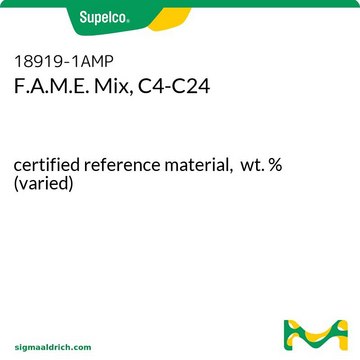62230
Acide linoléique
analytical standard
Synonyme(s) :
Acide cis-9,cis-12-octadecadiénoïque
About This Item
Produits recommandés
Qualité
analytical standard
Niveau de qualité
Pureté
≥98.0% (GC)
Durée de conservation
limited shelf life, expiry date on the label
Technique(s)
HPLC: suitable
gas chromatography (GC): suitable
Indice de réfraction
n20/D 1.466 (lit.)
n20/D 1.470
Point d'ébullition
229-230 °C/16 mmHg (lit.)
Pf
−5 °C (lit.)
Densité
0.902 g/mL at 25 °C (lit.)
Application(s)
cleaning products
cosmetics
flavors and fragrances
food and beverages
personal care
Format
neat
Groupe fonctionnel
carboxylic acid
Température de stockage
2-8°C
Chaîne SMILES
OC(CCCCCCC/C=C\C/C=C\CCCCC)=O
InChI
1S/C18H32O2/c1-2-3-4-5-6-7-8-9-10-11-12-13-14-15-16-17-18(19)20/h6-7,9-10H,2-5,8,11-17H2,1H3,(H,19,20)/b7-6-,10-9-
Clé InChI
OYHQOLUKZRVURQ-HZJYTTRNSA-N
Vous recherchez des produits similaires ? Visite Guide de comparaison des produits
Description générale
Application
- Multi-residue analysis of oleic acid and other related fatty acids using a derivatization-free method based on gas chromatography-flame ionization detection (GC-FID)
- Separation and quantification of palmitic, oleic, linoleic, and linolenic acids from 186 samples of sea buckthorn seed oil using near-infrared spectroscopy (NIR) in combination with four different combinations of multivariate calibration methods— partial least squares (PLS), PLS-uninformative variables elimination (UVE), PLS- competitive adaptive reweighted sampling (CARS), and multiple linear regression (MLR)-UVE
- Separation and determination of fatty acids by gas chromatography (GC) and amino acids by ultra-fast liquid chromatography-ultraviolet (UFLC-UV) detection from goldband goatfish harvested during different seasons
- Ultra-performance liquid chromatography-mass spectrometry (UHPLC) method-based separation, identification, and determination of eight saturated and unsaturated fatty acids in eight different commercial samples of olive oil without any prior sample treatment
- Magnetic solid-phase extraction of free fatty acids from edible oil samples using monodisperse magnetic single-crystal ferrite (Fe3O4) nanoparticles for their determination by gas chromatography-flame ionization detection (GC-FID)
Actions biochimiques/physiologiques
Autres remarques
Code de la classe de stockage
10 - Combustible liquids
Classe de danger pour l'eau (WGK)
WGK 1
Point d'éclair (°F)
>235.4 °F - closed cup
Point d'éclair (°C)
> 113 °C - closed cup
Équipement de protection individuelle
Eyeshields, Gloves
Faites votre choix parmi les versions les plus récentes :
Déjà en possession de ce produit ?
Retrouvez la documentation relative aux produits que vous avez récemment achetés dans la Bibliothèque de documents.
Les clients ont également consulté
Articles
The potential for the prevention and treatment of cardiovascular disease through increased dietary intake of omega-3 (w-3) fish oils is not a recent scientific discovery.
Protocoles
HPLC Analysis of Free Fatty Acids on SUPELCOSIL™ LC-8
Notre équipe de scientifiques dispose d'une expérience dans tous les secteurs de la recherche, notamment en sciences de la vie, science des matériaux, synthèse chimique, chromatographie, analyse et dans de nombreux autres domaines..
Contacter notre Service technique










